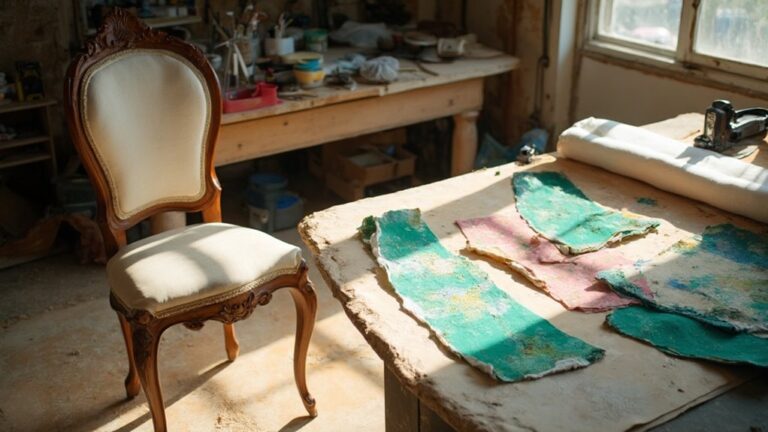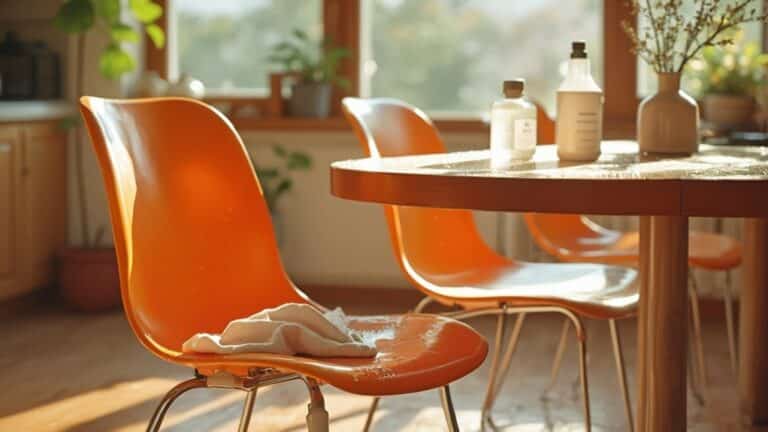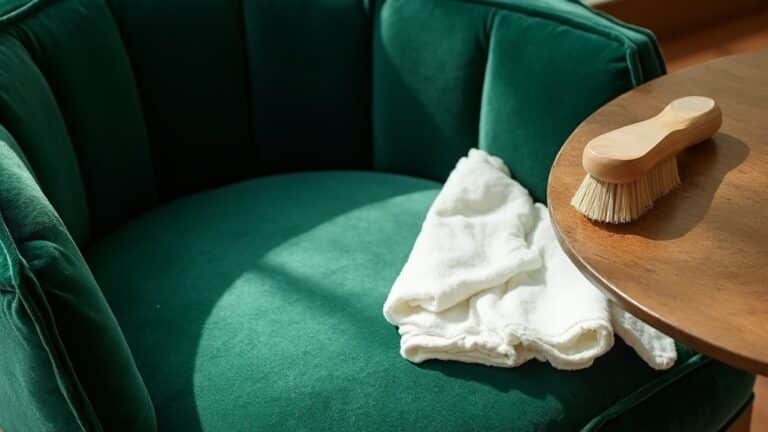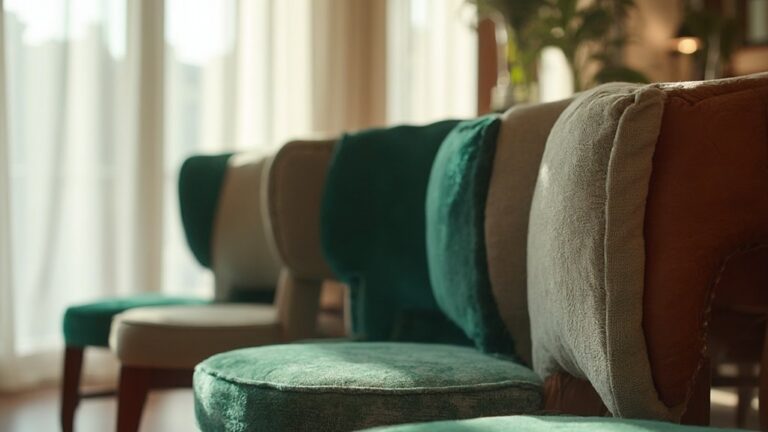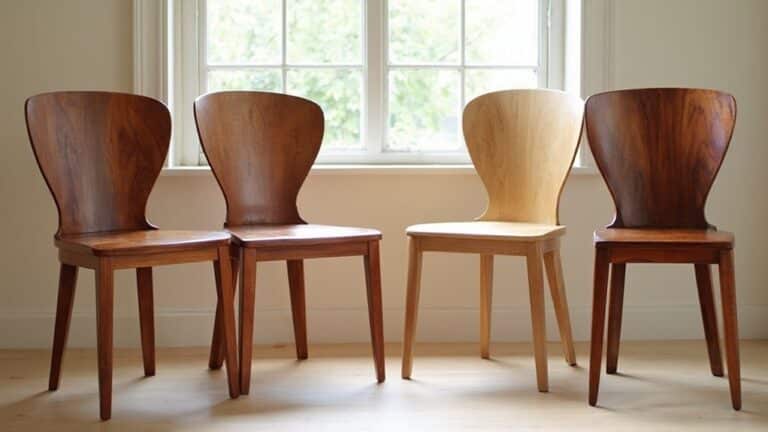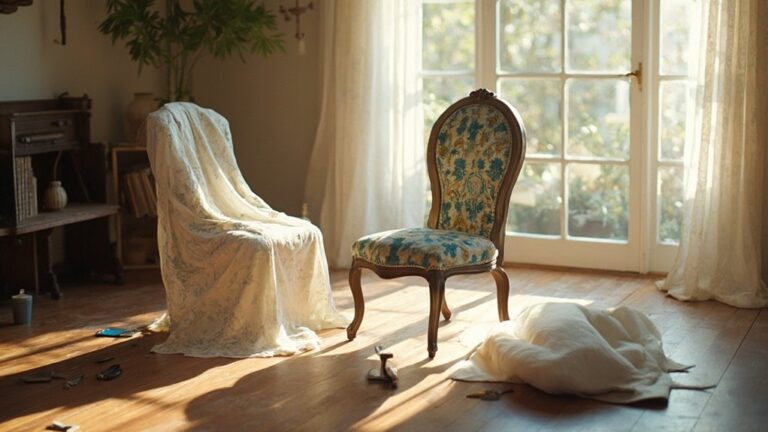What Is the Best Leather for Dining Chairs?
When it comes to selecting the best leather for your dining chairs, it is crucial to evaluate various types and their unique characteristics. Each leather type has its own set of advantages and drawbacks that can impact durability, maintenance, and style. You might find that what suits your aesthetic vision doesn’t always align with practicality. Let’s explore the different options available and help you decide which leather will truly meet your needs.
Understanding Leather Types for Dining Chairs
When choosing leather for your dining chairs, it’s essential to understand the different types available, as each offers unique qualities and benefits.
Top grain leather is popular for its durability and soft feel, making it an excellent choice for high-quality dining chairs. While it requires regular maintenance to keep its appearance, its ability to be dyed in various shades provides versatility in design. Many dining chairs, like the Kayla Leather Dining Chair, utilize this type of leather for both comfort and style.
On the other hand, semi-aniline leather strikes a balance between durability and affordability, ideal for mid-range options. It maintains a stylish look with less upkeep.
Finally, corrected semi-aniline leather offers enhanced durability and easy maintenance for those seeking practicality without sacrificing aesthetics.
Understanding these options helps you make an informed choice for your dining space.
Full Grain Leather: The Premium Choice
For those seeking the ultimate in quality and elegance, full grain leather stands out as the premium choice for dining chairs. This luxurious material not only enhances the aesthetic of your dining area but also offers incredible durability, making it a popular choice among Singapore homeowners for its elegance and functionality.
Here are some key benefits:
- Natural Beauty: Retains unique grain and imperfections, adding character.
- Long-lasting: Exceptionally durable and resistant to wear and tear.
- Comfort: Provides a soft, warm seating experience.
- Patina Development: Grows more beautiful over time, enhancing its appeal.
Though it requires regular maintenance to preserve its beauty, investing in full grain leather guarantees your dining chairs remain an exquisite focal point in your home for years to come.
Top Grain Leather: A Balance of Quality and Affordability
While you might seek the elegance of leather dining chairs without breaking the bank, top grain leather offers an ideal solution. It strikes a balance between quality and affordability, boasting a lifespan of 10-20 years with proper care. This leather is more durable than bonded leather and delivers a luxurious feel with a consistent appearance. Although it doesn’t develop as pronounced a patina as full-grain leather, it still offers a natural elegance. Understanding the pros and cons of each material is essential to making an informed choice. Maintenance is straightforward—just wipe spills with a damp cloth. While it may be prone to scratches, its resistance to allergens makes it a practical choice for many homes. With price ranges typically between $400 and $600, it’s a worthwhile investment for stylish dining chairs.
Aniline Leather: Luxurious but Demanding
Top grain leather offers a practical option for those seeking quality without breaking the bank, but if you’re after the pinnacle of luxury, aniline leather is the way to go.
This high-quality material boasts a soft and supple feel, perfect for upscale dining chairs. However, keep in mind it requires diligent care. Aniline leather is made from European hides vacuum-dried in Italy, ensuring a smooth grain and a luxurious appearance.
Here are some key points to contemplate:
- Natural Beauty: Aniline leather retains the hide’s unique texture and markings.
- Maintenance: Regular conditioning and protection from sunlight are essential.
- Susceptibility: It’s prone to scratches and stains, so handle with care.
- Cost: Expect a higher price tag due to its premium quality and dyeing process.
Invest wisely, and your aniline leather will age beautifully.
Nubuck Leather: Softness and Durability
Nubuck leather stands out for its remarkable softness and durability, making it an excellent choice for dining chairs. This leather’s softness comes from short protein fibers created during the sanding process, resulting in a matte finish with a slight nap.
It’s comfortable and breathable, offering a delightful seating experience. Nubuck is more durable than suede, as it’s made from the outer layer of the hide, capable of withstanding daily wear without showing signs of aging. Additionally, many dining chairs, like the Mid-Century style dining chair, feature this luxurious material, enhancing both comfort and aesthetic appeal.
While it can scratch easily, it holds up well over time. With regular maintenance, like using a soft brush or cloth, you can keep your chairs looking fresh.
Corrected Grain Leather: Cost-Effective Option
If you’re looking for a cost-effective way to incorporate leather into your dining chairs, corrected grain leather might be the solution you need. This type of leather is created by sanding down top-grain leather and pressing a faux grain onto it, resulting in a uniform appearance that’s budget-friendly.
Here are some key points to take into account:
- Affordability: It’s more cost-effective than full-grain or top-grain leather.
- Mass Production: Often used in mass-produced items, controlling costs considerably.
- Aesthetic Appeal: Offers a smooth look that suits modern designs.
- Lower Quality: While visually appealing, it lacks the durability and natural feel of higher-quality leathers. Additionally, many consumers may notice that potential flaws may surface after use due to the nature of the material.
Using corrected grain leather can give you the look of leather without breaking the bank!
Durability and Longevity of Leather Options
When choosing leather for your dining chairs, consider the strength of full-grain leather and the resilience of top-grain leather. Each type offers unique durability, but proper maintenance can greatly impact their longevity. Understanding these factors will help you make an informed decision that suits your lifestyle. Additionally, genuine leather is highly sought after for its long-lasting quality, making it a worthwhile investment for dining furniture.
Full Grain Strength
While many leather options exist, full-grain leather stands out for its remarkable strength and longevity. This premium material isn’t sanded or buffed, allowing its natural beauty to shine through.
When you choose full-grain leather for your dining chairs, you’ll enjoy several benefits:
- Durability: It withstands daily wear and tear, lasting decades with proper care.
- Natural Look: The unique grain and texture add character to your space.
- Resistance to Spills: It handles spills with ease, making it ideal for dining areas.
- Environmental Benefits: Being biodegradable, it’s a sustainable choice for eco-conscious homeowners. Additionally, full-grain leather is known for its longevity, which ensures that your investment will last for years to come.
Investing in full-grain leather means you’re choosing quality that stands the test of time.
Top Grain Resilience
Building on the strength and longevity of full-grain leather, top-grain leather offers a compelling alternative that combines durability with a luxurious feel. Derived from the uppermost layer of animal hide, it’s highly durable and designed to withstand regular use, making it ideal for dining chairs. With a lifespan of 20–30 years when properly cared for, top-grain leather outlasts fabric and synthetic materials. Its uniform appearance and softness provide a rich, comfortable seating experience. Additionally, a slight coating enhances its stain resistance, ensuring it looks great over time. Top grain leather can last up to four times longer than fabric options, making it a wise choice for high-traffic dining areas.
Maintenance Impact on Durability
Proper maintenance greatly influences the durability and longevity of leather dining chairs, ensuring they remain an attractive and functional part of your home for years to come. Leather is known for its exceptional durability, making it an excellent choice for daily use and hosting gatherings.
To keep your chairs in top shape, follow these essential maintenance tips:
- Regular Cleaning: Dust and wipe down your chairs to prevent dirt buildup.
- Spill Management: Clean spills immediately with a damp cloth and mild soap.
- Conditioning: Apply a leather conditioner every 6-12 months to keep the leather supple.
- Sunlight Protection: Avoid direct sunlight exposure to prevent fading and cracking.
Maintenance Tips for Different Leather Types
To keep your leather dining chairs looking their best, establish a regular cleaning schedule that suits the type of leather you have. Selecting the correct type of leather is crucial for upholstery projects, so understanding your leather’s characteristics can aid in proper maintenance. Stain prevention is key, so make sure to clean up spills quickly and consider applying a protective coating. Don’t forget to condition the leather regularly to maintain its softness and durability.
Regular Cleaning Schedule
Maintaining the beauty and longevity of your dining chairs is essential, and a regular cleaning schedule tailored to the type of leather can make all the difference.
Here’s a quick guide for each leather type:
- Full-Grain Leather: Dust regularly, clean with a damp cloth and mild soap, dry thoroughly, and condition every 6-12 months. Full-grain leather is known for its durability and unique patina, making it a worthwhile investment for your dining space.
- Top-Grain Leather: Wipe down with a damp rag, use mild non-detergent soap, guarantee it doesn’t soak, and dry completely.
- Bonded Leather: Clean gently with a damp cloth, avoid harsh chemicals, dry quickly, and inspect for wear.
- General Tips: Dust weekly, deep clean every few months, test cleaners first, and store in a dry, temperature-controlled space.
Following these steps will keep your leather dining chairs looking great.
Stain Prevention Tips
While enjoying your dining experience, it’s crucial to protect your leather chairs from stains and damage.
For full-grain leather, avoid direct sunlight to prevent fading and clean stubborn stains with a leather-specific cleaner. Gently wipe spills with a damp cloth and treat scratches promptly.
If you have top-grain leather, use mild soap for stains and regularly vacuum to remove debris. Keep it away from heat sources and use a conditioner to maintain suppleness.
Aniline leather requires extra care; keep it out of direct light and use a damp cloth for spills.
For semi-aniline leather, use a designated cleaner and regularly wipe the surface.
Always avoid harsh chemicals to keep your leather looking its best.
Conditioning and Protection
When it comes to keeping your leather dining chairs looking their best, regular conditioning and protection are essential.
Here are some key tips to maintain different leather types:
- UV Protection: Apply UV protectants regularly to prevent drying and cracking.
- Conditioning Schedule: Condition your chairs 2-4 times a year, adjusting for leather type. For instance, genuine leather chairs may require more frequent conditioning due to their natural properties.
- Choose Quality Products: Use high-quality conditioners specific to your leather type to avoid damage.
- Avoid Over-Conditioning: Don’t overdo it; excess conditioner can leave a sticky residue and degrade quality.
Choosing the Right Leather for Your Design Aesthetic
How do you choose the right leather for your dining chairs to match your design aesthetic?
Start by considering your style. For a modern look, opt for sleek full grain or top grain leather that showcases natural textures. Full-grain leather is known for its durability and unique patina, making it an excellent choice for high-end dining chairs.
If you prefer traditional styles, rich, corrected grain leather with ornate wood frames can create warmth. Mid-century modern designs benefit from nubuck leather’s soft feel, while Scandinavian minimalism pairs well with simple, elegant finishes.
Don’t forget color; classic blacks and browns work for most settings, but bold hues can make a statement. Finally, think about comfort—cushioned seats and ergonomic designs guarantee your dining experience is as pleasing as the aesthetics you choose.
Frequently Asked Questions
How Can I Tell if Leather Is Genuine?
To tell if leather’s genuine, feel for uneven texture and look for natural imperfections. Genuine leather smells rich, has rough edges, and displays unique markings. Avoid vague labels; seek clear indications of quality.
What Are the Environmental Impacts of Leather Production?
Leather production greatly harms the environment. You’ll notice chemical pollution, deforestation, and greenhouse gas emissions. Additionally, it consumes vast water resources, leading to habitat loss and health risks for communities near tanneries.
Can Leather Dining Chairs Be Repaired if Damaged?
Yes, you can repair leather dining chairs if they’re damaged. For minor issues, use DIY kits; for extensive damage, consider hiring a professional. Regular maintenance helps prevent issues, making repairs easier when needed.
How Do I Remove Stains From Leather Furniture?
To remove stains from leather furniture, first vacuum and spot test. For water or ink stains, use a damp cloth or rubbing alcohol. Always follow with a conditioner to keep the leather supple and protected.
Is Vegan Leather a Good Alternative for Dining Chairs?
Yes, vegan leather can be a good alternative for dining chairs. It’s lightweight, waterproof, and easy to maintain. Just keep it out of direct sunlight and avoid excessive moisture to guarantee its longevity.
Conclusion
When choosing the best leather for your dining chairs, consider your lifestyle and preferences. Full grain leather offers unparalleled beauty and durability, while top grain strikes a balance between quality and price. If you prefer a softer feel, nubuck might be your best bet. Remember to think about maintenance and how each type fits your design aesthetic. Ultimately, selecting the right leather will enhance your dining experience and elevate your home’s style.
References
- https://www.rolfordleather.com/blogs/leather-buying-guide/what-is-the-best-leather-for-upholstery
- https://www.clipopuk.com/blogs/news/how-to-choose-the-perfect-leather-dining-chair
- https://worldinteriors.com/blogs/before-you-buy-materials-construction-and-build-processes/the-chair-upholstery-guide-suede-top-grain-leather-linen
- https://runyonsfinefurniture.com/blogs/everything-runyons/why-leather-the-timeless-appeal-of-leather-dining-chairs
- https://www.houzz.com/products/dining-chairs/material–Leather
- https://www.perigold.com/furniture/sb1/genuine-leather-dining-chairs-c1866857-a125029~396866.html
- https://aytmdesign.com/shop/furniture/seating/chair/semper-dining-chair
- https://www.nogarlicnoonions.com/a-complete-guide-to-dining-chair-materials-which-is-right-for-you/
- https://gusmodern.com/en-us/products/cardinal-dining-chair
- https://www.prestige-affairs.com/blogs/how-to/leather-dining-chairs-singapore-s-best-options



